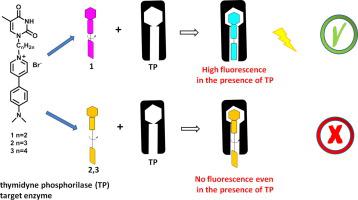Bioorganic & Medicinal Chemistry ( IF 3.3 ) Pub Date : 2020-11-21 , DOI: 10.1016/j.bmc.2020.115881 Manuela Petaccia 1 , Luisa Giansanti 1 , James N Wilson 2 , Heajin Lee 2 , Sara Battista 3 , Giovanna Mancini 4

|
Three new fluorescent molecular rotors were synthesized with the aim of using them as sensors to dose thymidine phosphorylase, one of the target enzymes of 5-fluorouracil, a potent chemotherapic drug largely used in the treatment of many solid tumors, that acts by hindering the metabolism of pyrimidines. 5-Fluorouracil has a very narrow therapeutic window, in fact, its optimal dosage is strictly related to the level of its target enzymes that vary significantly among patients, and it would be of the utmost importance to have an easy and fast method to detect and quantify them.
The three molecular rotors developed as TP sensors differ in the length of the alkylic spacer joining the ligand unit, a thymine moiety, and the fluorescent molecular rotor, a [4-(1-dimethylamino)phenyl]-pyridinium bromide. Their ability to trigger an optical signal upon the interaction with thymidine phosphorylase was investigated by fluorescent measurements.
中文翻译:

荧光分子转子作为检测胸苷磷酸化酶的传感器
合成了三个新的荧光分子转子,目的是将它们用作传感器来给药胸苷磷酸化酶,这是 5-氟尿嘧啶的靶酶之一,5-氟尿嘧啶是一种有效的化疗药物,主要用于治疗许多实体瘤,通过阻碍新陈代谢发挥作用嘧啶。5-氟尿嘧啶的治疗窗很窄,事实上,其最佳剂量与其靶酶水平密切相关,患者之间差异很大,因此最重要的是有一种简单快速的方法来检测和量化它们。
开发为 TP 传感器的三个分子转子在连接配体单元、胸腺嘧啶部分和荧光分子转子、[4-(1-二甲基氨基)苯基]-溴化吡啶鎓的烷基间隔的长度上有所不同。通过荧光测量研究了它们在与胸苷磷酸化酶相互作用时触发光信号的能力。











































 京公网安备 11010802027423号
京公网安备 11010802027423号